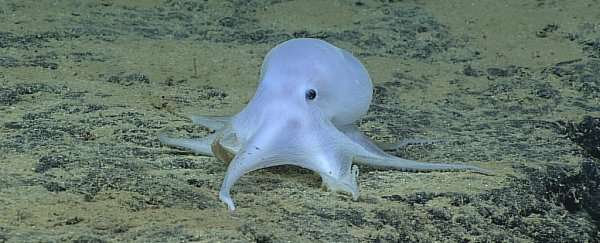The National Oceanic and Atmospheric Administration's (NOAA) Okeanos Explorer just completed its first operational dive of 2016. Its mission was to explore an area in the Hawaiian Archipelago to gather information about the sea floor between Necker Island and Necker Ridge. But the whole thing was undermined by the appearance of a tiny, adorable, ghost-like octopus that may represent a never-before-seen species.
The ridiculously cute discovery came when the team was using the Deep Discoverer, a remotely operated vehicle (ROV), to collect geological samples from the sea floor about 4,290 metres (14,000 feet) under the surface. Everything was going as planned until the ROV came upon a flat rock covered in sediment with a small, white octopus hanging out on top of it.
"The appearance of this animal was unlike any published records, and was the deepest observation ever for this type of cephalopod," the team announced.
These types of deep-sea octopuses are broken up into two different groups: cirrate (or Dumbo octopuses) and incirrate octopuses. Cirrate octopuses are known for their finned sides and cirri-covered arms while incirrate octopods have neither.
Researchers believe that the newly photographed specimen belongs to the incirrate group, but was unlike any incirrate they've ever countered. The team explains:
"[T]his animal was particularly unusual because it lacked the pigment cells, called chromatophores, typical of most cephalopods, and it did not seem very muscular. This resulted in a ghost-like appearance, leading to a comment on social media that it should be called Casper, like the friendly cartoon ghost. It is almost certainly an undescribed species and may not belong to any described genus."
Another interesting note is that this is the first time an incirrate octopus has been observed at such a depth, which furthers the hypothesis that it's a previously unknown species.
Despite all the evidence to support their hypothesis, the team will still have to go through the lengthy process of proving that the photogenic octopus is, in fact, a new species. Until then, at least we have some great pictures to hold us over.
